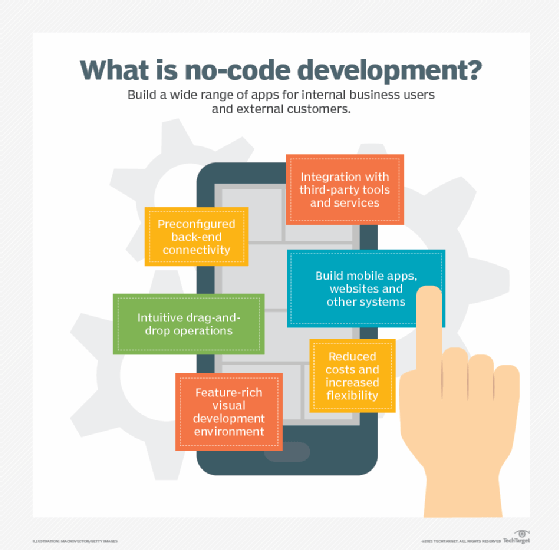Excellent Advice To Picking Low-Code Platform Examples
Excellent Advice To Picking Low-Code Platform Examples
Blog Article
Development Of Low-Code Apps Is Quicker.
Development of low-code applications significantly increases development speed due to several important factors. Development Environment:
Drag-and-Drop Interfaces: Low-code platforms provide visual tools for designing applications. Developers can use drag-and-drop components to build applications quickly without writing extensive code.
Many low-code platforms include already-built templates or components that enable developers to quickly build prototypes of their applications and build them without needing to start with a blank slate.
Coding Requirements Reduced
Automated Coding Generation Low code platforms generate code automatically in accordance with the visual model designed by the developers. This eliminates the requirement for manual code writing and speed up the development process.
Reusable Components : Developers are able to reuse components in various projects to cut down on the amount of time needed to write and testing codes.
A more efficient collaboration
Low-code platforms have a myriad of tools that facilitate seamless collaboration between development teams. These include testing, version control and deployment.
Citizen Development (Citizen Development) Developers and users of business applications are able to participate in application development by making use of intuitive interfaces. This reduces the bottleneck caused by the limited professional developer availability.
Rapid Iteration and Prototyping:
Fast Prototyping : Developers create prototypes in a short time to validate ideas and collect feedback. This leads to faster iteration cycles.
Easy Modifications - The visual nature of low-code development permits for simpler updates and modifications, which speeds the refinement of applications based on user feedback.
Pre-built Integrations:
API Integrations: Platforms that are low-code usually include pre-built connectors to APIs and services that are popular making it easier to integrate with external systems.
Data Integration: The tools integrated into the software simplify and accelerate the process of connecting databases, data sources and applications.
Deployment, scaling and deployment
Many low-code platforms have the option of deploying applications with one click, which reduces the amount of time and effort needed to set up applications.
Cloud-Based Solution: Cloud based low code platforms are capable of handling infrastructure management and scaling. This lets developers concentrate on application logic, functionality and features instead of the logistics of deployment.
The most significant benefit of low code application development with regard to speed, is its capacity to automatize and simplify many aspects in the development process. This allows for faster delivery of applications, and more rapid adaptation to changing requirements. See the top rated Low-code Platform for application development hints for website examples including develop web application, azure sql server, low code development platforms, multiplatform mobile app development, develop mobile application, jdbc server, sso azure, build with docker, mobile development platforms, develop cross platform mobile app and more.
Benefits Of Low-Code Application Development In Terms Of Flexibility And Scale
Low-code development offers numerous advantages in terms of flexibility and scalability, which is crucial to creating applications that are able to grow and adapt to changing business needs. Here are a few of the main benefits.
Cloud-based deployment: Many low-code applications are cloud-based that allow applications to scale easily with the cloud infrastructure. This lets companies handle the increasing demands without worry about managing servers.
Auto-Scaling: This feature can automatically adjust the resources based on demand. This will ensure consistent performance at peak times and without manual intervention.
Flexible Architecture:
Modular Design: Low-code platforms encourage the modular design of applications, allowing components to be developed independently and tested, as well as scalable. This modularity enhances flexibility and allows to upgrade or expand certain parts of a program without affecting the whole system.
Microservices Architecture: Microservices architecture supports the creation of applications by creating a loosely coupled collection of services. This improves the flexibility and scalability.
Customizable Solutions
Extensibility Low-code platforms typically permit custom programming and scripting. This allows developers to enhance the capabilities of their applications beyond what comes out of the box. This allows companies to meet their own unique requirements.
Third-Party Integrations: Integration to third-party APIs and services enables businesses to add additional functions to their software.
Agile Development & Deployment
Continuous Delivery and Deployment Low-code platforms support agile methods enabling continuous integration, continuous delivery (CI/CD). This allows for rapid deployment and updates of new features.
Iterative Development: The nature of low-code development implies applications are able to be incrementally improved and expanded, reducing risk associated with large-scale changes and allows for more controlled growth.
Resource Optimization
Efficiency in Resource Management: Low-code systems allow you to optimize resource usage by providing tools for monitoring and managing application performance. This helps ensure that resources are utilized effectively and can be scaled to meet actual needs.
Load Balancing: The integrated load balancing feature divides the workload equally among servers. This increases the application's capacity to handle high traffic and also ensures the same performance.
Global Reach
Multi-Region Deployment: Low-code systems often support deployment across multiple geographical regions, allowing companies to offer low-latency connectivity to users around the world. This is especially important for applications with users across the globe.
Localization Support for Localization included, which allows applications to be easily adaptable to various languages or regional needs. This allows for greater flexibility in various markets.
Maintenance and updates
Low-code software is visually appealing and modularly designed, which simplifies maintenance. Updates and bug fixes can be completed quickly and without lengthy downtime.
Version Control System for Version Control: These integrated versions handle rollbacks and changes to ensure that updates can safely be made and that older versions are restored when needed.
Cost Efficiency:
Lower development costs: Low-code platforms permit a reduction in the development cost, by removing the need to code extensively. This allows applications to be scaled without an increase of costs or development time.
Pay-As you Go Models A lot of platforms for low-code provide flexible pricing options, including pay-as-you go model that aligns the cost and usage to actual growth.
The majority of low-code app developers offer a high level of flexibility and scalability that allows businesses to quickly build adaptable and flexible applications. These platforms can quickly adjust to changing demands and efficiently use resources, and constantly enhance, allowing both applications and businesses alike to grow and grow. Check out the best Enterprise application development with Low-code Platform blog for site advice including push notifications, software for app development, cross platform app dev, develop cross platform mobile app, rad development, azure sql server, azure sql, rapid app development, application modernization, rapid applications and more.
Benefits Of Low-Code Application Development In Terms Of Customization And Constraints
Low-code applications offer an integrated approach that offers substantial advantages when it comes to dealing with limitations and permitting customisation. These are the main advantages: Handling limitations
In overcoming Complexity Barriers:
Simplified Development : Low-code platform reduces complexity by providing templates and components that are pre-built, allowing for faster creation and deployment.
Guided Workflows: Many platforms offer guided workflows or wizards to aid developers in navigating complicated processes. This decreases the possibility of errors and assures accuracy.
Scalability Solutions
Scalability Built-In: Lowcode platforms usually include features to support scalable architecture. They permit applications to handle growing loads without requiring major overhauls.
Performance Monitoring Tools: tools for monitoring and optimizing performance are built in the application to ensure it's efficient regardless of how it expands.
Security and compliance
Integrated security features: Low-code platforms include security measures such as encryption as well as role-based access control and automated compliance checks that address the most common security concerns.
Platforms regularly update their security and compliance measures to ensure that their applications are safe from new threats.
Features for Customization:
Extensibility:
Custom Code Integration: Low-code platforms often allow the integration of custom codes (e.g., JavaScript, Python), enabling developers to expand the capabilities beyond what is available in the standard features.
Custom Modules and Plugins: Developers have the option to create customized modules or plugins in order to modify specific functionality to meet specific business requirements.
APIs and Integration
API Support - Comprehensive support of APIs facilitates seamless integration with other services and systems and permits extensive customisation.
Third-Party Service: Low-code platforms come with pre-built connectors for popular third-party service providers, making it simple to integrate and customize applications.
Designing UI/UX that is flexible:
Customizable interfaces: Users can customize and design their own user interfaces which will provide an experience that is more customized.
Responsive design: The capability to customize applications for different devices and screens is built-in.
Custom Business Logic for Businesses:
Visual Workflow Builds: Visual tools that permit the modification of workflows and business rules and to design complex customized procedures.
Conditional Logic and scripting: Platforms allow the use of conditional logic and custom scripting that can handle certain business rules and scenarios.
Data Management:
Custom Data Modelling: Developers create custom models that meet specific application needs. They can customize processing of data according to a company's specifications.
Advanced Data Processing: Integration with the latest data processing tools and capabilities allows for customizing how data is analyzed and utilized within the application.
Balancing Limitations with Customization:
Frameworks and Standards:
Best Practices for Compliance Low-code platforms promote the use of industry-leading practices and standards. This aids in maintaining high-quality, flexible, and secure apps.
Governance Frameworks. The built-in governance frameworks ensure that any modifications are not detrimental to the integrity, security or security of the application.
Iterative Development:
Rapid Prototyping: The ability to quickly prototype and test modifications allows developers to refine their applications based on feedback from users, refining the application to better satisfy the user's needs.
Continuous Improvement: Platforms using low-code support for continuous improvement, allowing customization and enhancement as the business requirements change.
User Empowerment
Empowering Citizen Developers by allowing non-developers to customize their applications using simple user interfaces, platforms that do not require code expand the number of users who can enhance and tailor applications.
Training and Support: Many platforms provide comprehensive training and support to assist users in making successful modifications that do not compromise the stability of the application or its performance.
In general, low-code development provides a solid framework to overcome limitations as well as a wealth of opportunities to personalize. This balance ensures that businesses are able to create and maintain apps that are functional and specifically tailored to their requirements, while maintaining the highest standards of security, quality, and scalability.